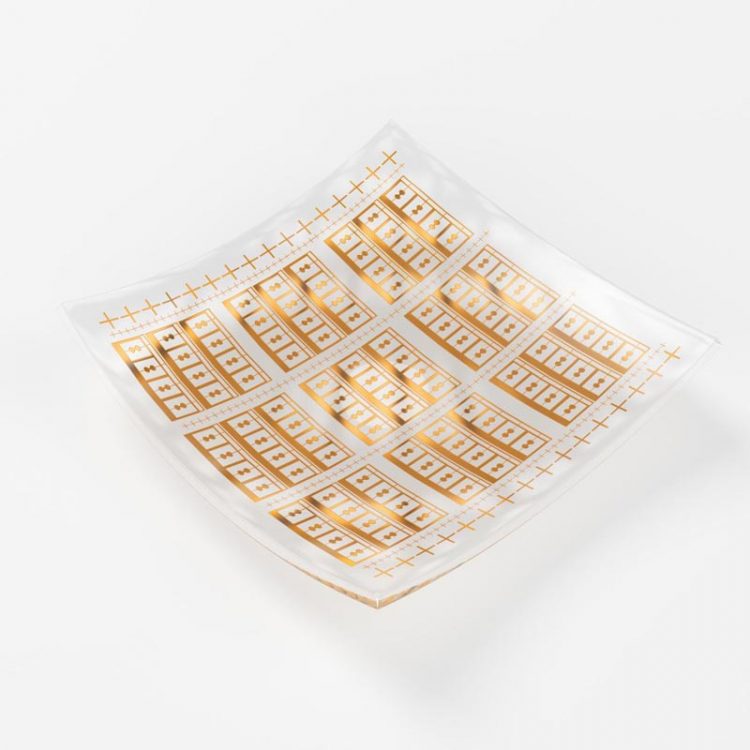Graphene enables high-speed electronics on flexible materials

With the help of the two-dimensional material graphene, the first flexible terahertz detector has been developed by researchers at Chalmers. The opportunities are great within health and Internet of Things, and for new types of sensors. Credit: Boid - Product Design Studio, Gothenburg/Chalmers University of Technology
Terahertz radiation has a wide range of uses and can occur in everything from radio astronomy to medicine. The term refers to the electromagnetic waves whose frequencies range from 100 gigahertz to 10 terahertz. Demand for higher bandwidth in wireless communications and depiction for security applications has led to intensified research on systems and components intended for terahertz frequencies.
One challenge has long been to enable low weight and cheap applications. However, advances in polymer technology have promoted the development of flexible electronics and enabled the production of high frequency units on flexible substrates.
Now, Chalmers researchers Xinxin Yang, Andrei Vorobiev, Andrey Generalov, Michael A. Andersson and Jan Stake have developed the first mechanically flexible and graphene-based terahertz detector in its kind. Thus, paving the way for flexible terahertz electronics.
The detector has unique features. At room temperature, it detects signals in the frequency range 330 to 500 gigahertz. It is translucent and flexible, and opens to a variety of applications. The technique can be used for imaging in the terahertz area (THz camera), but also for identifying different substances (sensor). It may also be of potential benefit in health care, where terahertz waves can be used to detect cancer. Other areas where the detector could be used are imaging sensors for vehicles or for wireless communications.
The unique electronic features of graphene, combined with its flexible nature, make it a promising material to integrate into plastic and fabric, something that will be important building blocks in a future interconnected world. Graphene electronics enables new applications for, among other things, everyday objects, which are commonly referred to as the Internet of Things.
The detector shows the concrete possibilities of graphene, a material that conduct electric current extremely well. It is a feature that makes graphene an attractive building block in fast electronics. The Chalmers researchers' work is therefore an important step forward for graphene in the terahertz area, and a breakthrough for high performance and cheap flexible terahertz technology.
The detector drew attention at the EU Tallinn Digital Summit recently, where several important technological innovations made possible by graphene and related materials were on display. At the summit, EU Heads of State and Government gathered to discuss digital innovation and Europe's digital future. The flagship focus was to show what role graphene can play.
The research is also part of Xinxin Yang's licentiate seminar, which will be presented at Chalmers on 22 November 2017.
###
The research on the terahertz detector has been funded by the EU Graphene Flagship, the Swedish Foundation for Strategic Research (SSF), and the Knut and Alice Wallenberg Foundation (KAW).
See video on Youtube about the new technology: Flexible terahertz detector
Read the article in the journal Applied Physics Letters: “A flexible graphene terahertz detector”
Media Contact
All latest news from the category: Information Technology
Here you can find a summary of innovations in the fields of information and data processing and up-to-date developments on IT equipment and hardware.
This area covers topics such as IT services, IT architectures, IT management and telecommunications.
Newest articles

New organoid with all key pancreas cells
Researchers from the Organoid group (previously Clevers group) at the Hubrecht Institute have developed a new organoid that mimics the human fetal pancreas, offering a clearer view of its early development….

Unlocking the potential of nickel
New study reveals how to use single atoms to turn CO2 into valuable chemical resources. Nickel and nitrogen co-doped carbon (Ni-N-C) catalysts have shown exceptional performance in converting CO2 into…

‘Spooky action’ at a very short distance
Scientists map out quantum entanglement in protons. Particles streaming from collisions offer insight into dynamic interactions and collective behavior of quarks and gluons. Scientists at the U.S. Department of Energy’s…



